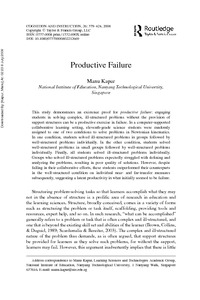Productive failureManu Kapur
Erstpublikation in: Cognition and Instruction, 26(3), 379-425.
Publikationsdatum:
|
 |
 Diese Seite wurde seit 1 Jahr inhaltlich nicht mehr aktualisiert.
Unter Umständen ist sie nicht mehr aktuell.
Diese Seite wurde seit 1 Jahr inhaltlich nicht mehr aktualisiert.
Unter Umständen ist sie nicht mehr aktuell.
 Zusammenfassungen
Zusammenfassungen
This study demonstrates an existence proof for productive failure: engaging
students in solving complex, ill-structured problems without the provision of
support structures can be a productive exercise in failure. In a computer-supported
collaborative learning setting, eleventh-grade science students were randomly
assigned to one of two conditions to solve problems in Newtonian kinematics.
In one condition, students solved ill-structured problems in groups followed by
well-structured problems individually. In the other condition, students solved
well-structured problems in small groups followed by well-structured problems
individually. Finally, all students solved ill-structured problems individually.
Groups who solved ill-structured problems expectedly struggled with defining and
analyzing the problems, resulting in poor quality of solutions. However, despite
failing in their collaborative efforts, these students outperformed their counterparts
in the well-structured condition on individual near- and far-transfer measures
subsequently, suggesting a latent productivity in what initially seemed to be failure.
Von Manu Kapur im Text Productive failure (2008)  Dieser Text erwähnt ...
Dieser Text erwähnt ...
 Personen KB IB clear | Katherine Bielaczyc , John Seely Brown , Richard E. Clark , Allan Collins , P. Duguid , Paul A. Kirschner , Jeremy Roschelle , John Sweller | |||||||||||||||||||||||||||||||||||||||||||||
 Begriffe KB IB clear |  Problemlösefähigkeit Problemlösefähigkeit problem solving skills problem solving skills
| |||||||||||||||||||||||||||||||||||||||||||||
 Bücher |
| |||||||||||||||||||||||||||||||||||||||||||||
 Texte |
|
 Zitationsgraph
Zitationsgraph
 Zitationsgraph (Beta-Test mit vis.js)
Zitationsgraph (Beta-Test mit vis.js)
 Zeitleiste
Zeitleiste
 9 Erwähnungen
9 Erwähnungen 
- CSCL 2009 (2009)

- Failures and Successes in Collaborative Inquiry - Learning the Physics of Electricity with Agent-Based Models (Suneeta A. Pathak, Beaumie Kim, Michael J. Jacobson, BaoHui Zhang)

- Failures and Successes in Collaborative Inquiry - Learning the Physics of Electricity with Agent-Based Models (Suneeta A. Pathak, Beaumie Kim, Michael J. Jacobson, BaoHui Zhang)
- ICER 2015 - Proceedings of the eleventh annual International Conference on International Computing Education Research, ICER 2015, Omaha, NE, USA, August 09 - 13, (Brian Dorn, Judy Sheard, Quintin I. Cutts) (2015)
- Boys' Needlework - Understanding Gendered and Indigenous Perspectives on Computing and Crafting with Electronic Textiles (Kristin A. Searle, Yasmin B. Kafai) (2015)


- Boys' Needlework - Understanding Gendered and Indigenous Perspectives on Computing and Crafting with Electronic Textiles (Kristin A. Searle, Yasmin B. Kafai) (2015)
- SIGCSE 2019 - Proceedings of the 50th ACM Technical Symposium on Computer Science Education, SIGCSE 2019, Minneapolis, MN, USA, February 27 - March 02, 2019 (Elizabeth K. Hawthorne, Manuel A. Pérez-Quiñones, Sarah Heckman, Jian Zhang 0036) (2019)
- Rethinking Debugging as Productive Failure for CS Education (Yasmin B. Kafai, David DeLiema, Deborah A. Fields, Gary Lewandowski, Colleen Colleen) (2019)


- Rethinking Debugging as Productive Failure for CS Education (Yasmin B. Kafai, David DeLiema, Deborah A. Fields, Gary Lewandowski, Colleen Colleen) (2019)
- Debugging im Informatikunterricht (Tilman Michaeli) (2020)


- WiPSCE '21 - The 16th Workshop in Primary and Secondary Computing Education, Virtual Event / Erlangen, Germany, October 18-20, 2021 (Marc Berges, Andraes Mühling, Michal Armoni) (2021)
- Effects of Hints on Debugging Scratch Programs - An Empirical Study with Primary School Teachers in Training (Luisa Greifenstein, Florian Obermüller, Ewald Wasmeier, Ute Heuer, Gordon Fraser) (2021)


- Effects of Hints on Debugging Scratch Programs - An Empirical Study with Primary School Teachers in Training (Luisa Greifenstein, Florian Obermüller, Ewald Wasmeier, Ute Heuer, Gordon Fraser) (2021)
- Motivation in unterrichtlichen fachbezogenen Lehr-Lernkontexten (Rebecca Lazarides, Diana Raufelder) (2022)


- Learning with a digital escape room game: before or after instruction? (Josef Buchner, Martina Rüter, Michael Kerres) (2022)


- Intelligentes Wissen – und wie man es fördert - Kognitiv aktivierende Lernformen für den mathematisch-naturwissenschaftlichen Unterricht (Ralph Schumacher, Elsbeth Stern) (2022)


- Anregende Unterrichtseinstiege - Wie können wir Schülerinnen und Schüler besser auf das Lernen vorbereiten? (Armin Barth, Roger Deuber, Tanja Frei, Brigitte Hänger, Juraj Lipscher)


- Anregende Unterrichtseinstiege - Wie können wir Schülerinnen und Schüler besser auf das Lernen vorbereiten? (Armin Barth, Roger Deuber, Tanja Frei, Brigitte Hänger, Juraj Lipscher)
- Educational Technologies for Vocational Training - Experiences as Digital Clay (Pierre Dillenbourg, Alberto Cattaneo, Jean-Luc Gurtner, Richard Lee Davis) (2022)


 Volltext dieses Dokuments
Volltext dieses Dokuments
 |  Productive failure: Artikel als Volltext ( Productive failure: Artikel als Volltext ( : :  , 172 kByte; , 172 kByte;  : :  Link unterbrochen? Letzte Überprüfung: 2021-03-21 Letzte erfolgreiche Überprüfung: 2010-05-13) Link unterbrochen? Letzte Überprüfung: 2021-03-21 Letzte erfolgreiche Überprüfung: 2010-05-13) |
 Anderswo suchen
Anderswo suchen 
 Beat und dieser Text
Beat und dieser Text
Beat hat Dieser Text während seiner Zeit am Institut für Medien und Schule (IMS) ins Biblionetz aufgenommen. Beat besitzt kein physisches, aber ein digitales Exemplar. Eine digitale Version ist auf dem Internet verfügbar (s.o.). Aufgrund der wenigen Einträge im Biblionetz scheint er es nicht wirklich gelesen zu haben. Es gibt bisher auch nur wenige Objekte im Biblionetz, die dieses Werk zitieren.









 (
(



 Biblionetz-History
Biblionetz-History